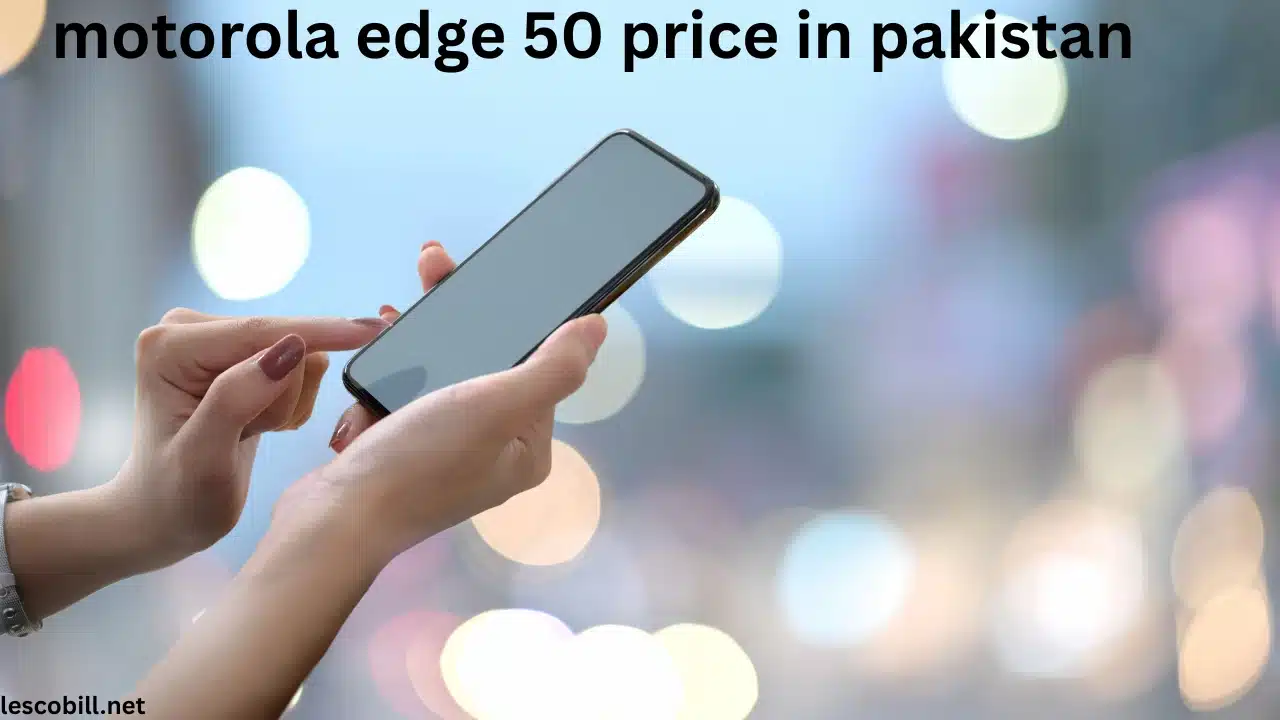The smartphone market in Pakistan continues to evolve, with tech lovers demanding better performance, sharper cameras, and sleek design—all at affordable rates. The Motorola Edge 50 price in Pakistan has captured the attention of many because it delivers an upper mid-range experience without crossing into flagship-level pricing. Packed with advanced features, this smartphone offers real value, especially for users who appreciate clean software and smooth performance.
Motorola, once a dominant name in the mobile industry, has made a comeback in several countries, including Pakistan. The Edge 50 plays a key role in that comeback, promising a balance of performance, design, and affordability.
You May Like: pakistan champions
Motorola Edge 50 Price in Pakistan – Latest Market Rates

As of mid-2025, the Motorola Edge 50 price in Pakistan starts from Rs. 134,999 for the base variant with 8GB RAM and 128GB storage. If you’re eyeing the more powerful 12GB RAM and 256GB storage variant, the price increases to around Rs. 154,999. These prices reflect the model’s growing demand and its specs, which rival more expensive competitors.
It is important to note that local taxes, import duties, and retailer pricing can cause slight variations. However, buyers generally find that the Motorola Edge 50 offers better value compared to other phones in the same price range.
Design and Display That Impresses
Motorola has focused on offering a modern and premium design with the Edge 50. The smartphone features a curved display, ultra-thin bezels, and a durable finish that resists smudges. With IP68 water and dust resistance, this device is built to last.
The 6.7-inch OLED display supports a 144Hz refresh rate. This makes it not just sharp and colorful but also extremely smooth while scrolling or gaming. HDR10+ compatibility enhances video content, offering a cinema-like experience. The display is bright enough to be used outdoors, and colors remain accurate even at wide viewing angles.
Build Quality and Color Variants
Motorola offers the Edge 50 in several stylish color options, including:
- Forest Grey
- Peach Fuzz
- Lunar Blue
The phone feels premium in the hand. Despite its large size, it remains comfortable due to the curved edges and well-distributed weight. The back has a soft matte texture that gives it a refined appearance. Motorola’s Pantone-certified colors stand out, especially the Peach Fuzz variant, which looks fresh and trendy.
Performance That Matches the Hype
The Motorola Edge 50 runs on the Qualcomm Snapdragon 7 Gen 3 processor. While not a flagship-level chip, it easily handles multitasking, high-end games, and video editing apps. Paired with up to 12GB RAM, the phone delivers stable performance throughout the day.
Whether you’re switching between social media apps, taking pictures, watching videos, or attending video calls, this phone keeps everything smooth. Benchmarks show that it performs slightly better than phones with MediaTek chips in the same price range.
Motorola includes UFS 3.1 storage, which is fast enough for rapid file transfers and quick app launches. You’ll also enjoy reliable GPU support for graphics-heavy applications.
Clean Software Experience with Android 14
Another major selling point of this device is its software. Motorola sticks to a near-stock Android 14 experience, enhanced slightly with its MyUX layer. This means you get minimal bloatware, faster updates, and a clean UI.
Motorola promises two years of Android OS updates and three years of security updates, keeping your phone relevant for a long time. Users who dislike heavy customizations or ads will love the Motorola Edge 50.
MyUX also includes features like gesture controls, always-on display, peek notifications, and more. These features enhance usability without overwhelming the system.
Camera Performance: Ready for Every Moment
Motorola has significantly improved its camera systems, and the Edge 50 reflects that. The phone features:
- 50MP main sensor with OIS
- 13MP ultra-wide lens
- 32MP front camera
The 50MP primary sensor captures detailed and vibrant images in various lighting conditions. The optical image stabilization helps reduce blur, especially when shooting at night or on the move. The ultra-wide lens allows you to capture broader landscapes or large group shots without backing up.
On the front, the 32MP camera delivers crisp selfies with accurate skin tones and facial details. Features like portrait mode, night mode, and AI beauty settings add versatility to your shots.
Video Recording and Camera Modes
The Motorola Edge 50 can shoot videos at 4K resolution at 30fps. With HDR support and enhanced stabilization, you get smooth and vibrant footage. The camera app includes multiple shooting modes such as:
- Dual capture (front and back camera simultaneously)
- Pro mode for manual settings
- Spot color
- Slow motion
Whether you’re an occasional photographer or someone who posts content regularly, the camera system will meet your needs.
Battery Life and Charging Speed
The phone houses a 4400mAh battery, which might seem small compared to some 5000mAh phones, but Motorola has optimized the system well. The phone easily lasts a full day with moderate to heavy usage.
One of the highlights is the 68W TurboPower fast charging support. You can go from 0% to 50% in just 20 minutes, and a full charge takes less than 45 minutes. The charger is included in the box, which is a plus in today’s market where some brands exclude it.
Battery optimization tools are built into the system. Features like battery saver mode, adaptive charging, and app sleeping contribute to longer screen-on time.
Network Support and Connectivity
Motorola Edge 50 comes with 5G support, ensuring future-proof connectivity. It also supports:
- Dual SIM 4G LTE
- Wi-Fi 6E
- Bluetooth 5.2
- NFC for contactless payments
- USB-C 3.1 for faster data transfers
The in-display fingerprint sensor is fast and accurate. Face unlock is also available and works reliably under good lighting.
Motorola Edge 50 Price in Pakistan Compared to Rivals
Let’s compare this phone with some of its key rivals in the Pakistani market:
| Phone | Price in PKR | Display | Main Camera | Battery | Charging |
|---|---|---|---|---|---|
| Motorola Edge 50 | 134,999 | 6.7” OLED 144Hz | 50MP | 4400mAh | 68W |
| Samsung A55 | 139,999 | 6.5” AMOLED 120Hz | 50MP | 5000mAh | 25W |
| Xiaomi 13 Lite | 132,999 | 6.55” AMOLED | 50MP | 4500mAh | 67W |
| Vivo V27 | 129,999 | 6.78” AMOLED | 64MP | 4600mAh | 66W |
Among these models, the Motorola Edge 50 offers the fastest display refresh rate and cleanest software experience. Although the battery is slightly smaller, the 68W charger makes up for it. The premium design and camera capabilities put it at par or ahead in most comparisons.
Storage Options and Expandability
The phone is available in two variants:
- 8GB RAM + 128GB Storage
- 12GB RAM + 256GB Storage
Unfortunately, Motorola does not offer expandable storage via a microSD card in this model. However, the internal storage is fast and sufficient for most users, including those who store media, apps, and games.
Audio and Multimedia
Motorola has included stereo speakers with Dolby Atmos in the Edge 50. Whether you’re watching movies or playing games, the sound is loud and rich. There is no headphone jack, so users need to rely on USB-C audio or wireless earbuds.
The combination of a vivid OLED screen and stereo sound makes this device ideal for streaming platforms, mobile gaming, and social media browsing.
Who Should Buy the Motorola Edge 50?
This phone is suitable for:
- Students who want a powerful phone with a good camera
- Content creators looking for fast performance and clear visuals
- Working professionals who need a durable, secure, and responsive phone
- Gamers who value high refresh rate displays and good thermal control
Motorola offers a great balance of style and substance in the Edge 50, making it a dependable daily driver.
Frequently Asked Question
What is the Motorola Edge 50 price in Pakistan?
The Motorola Edge 50 price in Pakistan starts from Rs. 134,999 for the 8GB RAM and 128GB storage variant. The higher-end version with 12GB RAM and 256GB storage costs approximately Rs. 154,999.
Does the Motorola Edge 50 support 5G in Pakistan?
Yes, the Motorola Edge 50 supports 5G connectivity and works seamlessly with Pakistani network providers that offer 5G services.
What is the battery capacity and charging speed of Motorola Edge 50?
The Motorola Edge 50 comes with a 4400mAh battery and supports 68W fast charging, allowing the phone to charge up to 100% in less than 45 minutes.
Is the Motorola Edge 50 good for gaming?
Absolutely. The phone’s Snapdragon 7 Gen 3 processor, 144Hz OLED display, and Adreno GPU make it ideal for gaming with smooth graphics and minimal lag.
How many Android updates will Motorola Edge 50 receive?
Motorola has promised 2 years of Android OS updates and 3 years of security patches, keeping the device up to date and secure for long-term use.
Motorola Edge 50 Price in Pakistan – Final Thoughts
The Motorola Edge 50 price in Pakistan proves that you don’t have to spend over two lakhs to get a solid, all-around smartphone. The device offers a vibrant OLED display, capable cameras, clean Android software, and fast charging, all wrapped in a premium body.
If you’re tired of bloated Android skins, poor battery life, or average performance in this price segment, the Motorola Edge 50 offers a refreshing change. Whether you’re upgrading from an older phone or switching brands, this model provides a high-value option in 2025.
People Aslo Read: kumrat valley




